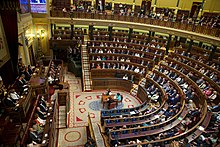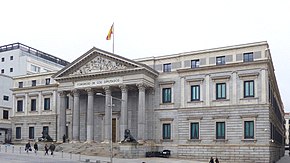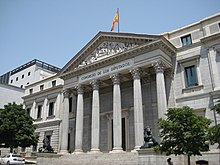Congreso de los Diputados
| logo | Palacio de las Cortes, seat of the House of Representatives |
|---|---|

|

|
| Basic data | |
| Seat: |
Palacio de las Cortes , Madrid |
| Legislative period : | 4 years |
| MPs: | 350 |
| Current legislative period | |
| Last choice: | November 10, 2019 |
| Chair: | Meritxell Batet ( PSOE ) |

|
|
| Distribution of seats: |
Government (155)
|
| Website | |
| www.congreso.es | |

The Congreso de los Diputados is the lower house of the Spanish Parliament , the Cortes Generales .
choice
According to Article 68 of the Spanish Constitution, the House of Representatives consists of 300 to 400 (currently 350) MPs who are elected by general, free, equal, direct and secret elections. The constitution contains the following further regulations: constituencies (circunscripciones) are the 50 provinces and the two exclaves Ceuta and Melilla in North Africa. There are therefore a total of 52 constituencies (Art. 68.2). The election takes place in the individual constituencies according to proportional representation (Art. 68.3).
The electoral law regulates the details (Ley Organica del Régimen Electoral General, LOREG). The regulations on the electoral system (i.e. how the votes cast are converted into seats) can be found there in Title II, Chapter III.
350 members are elected (Art. 162.1 LOREG). The distribution to the individual constituencies is regulated as follows: Ceuta and Melilla each have one MP, and each province receives two seats in advance (Art. 162.2 LOREG). So 102 seats have already been distributed. The remaining 248 are distributed to the provinces in proportion to the population according to the Hare-Niemeyer method (Art. 162.3 LOREG).
Because of the vastly different population numbers of the Spanish provinces, this also leads to large differences in the number of representatives to be elected in the constituencies. In the election on December 20, 2015, there were two constituencies (Ceuta and Melilla) with one MP, one constituency with two MPs, eight constituencies with three MPs, nine constituencies with four MPs, eight constituencies with five MPs, seven constituencies with six MPs, four constituencies with seven MPs, five constituencies with eight MPs, one constituency with nine MPs, one constituency with ten MPs, one constituency with eleven MPs, two constituencies with twelve MPs, one constituency with 15 MPs and the two largest constituencies Barcelona and Madrid with 31 and 36 MPs respectively.
The distribution of the seats takes place exclusively at the level of the constituencies, there are no residual votes at the national level. At the constituency level, the electoral law provides for a 3% threshold . However, the actual percentage threshold is much higher in almost all constituencies because of the small number of mandates to be awarded.
As a result, smaller nationally competing parties only have a chance of winning a mandate in the largest constituencies. The votes cast for them in smaller constituencies in which they cannot win a mandate are lost. Conversely, the system means that the regional parties, which are strong in Spain, particularly in Catalonia and the Basque Country, are represented in the House of Representatives, even if their share of the vote at national level is low. For example, For example, in the 2015 election to the Canarian regional party Coalición Canaria with almost 82,000 votes (0.32% at national level) one mandate, but the IU with over ten times more votes received only two mandates.
Seats are allocated according to the D'Hondt procedure .
The last election took place on April 28, 2019 .
Legislative period
The legislative period is four years (calculated from the day of the election).
The House of Representatives is prematurely dissolved by law in the following cases: after a new election of the House of Representatives or another execution of the office of the Prime Minister (lost vote of confidence, resignation, death), the election of a Prime Minister does not take place or if a proposal for a "total revision" of the constitution is accepted .
After hearing the government, the Prime Minister can also propose to the King at any time, and without any special conditions, that the House of Representatives be dissolved (Art. 115 of the Constitution). The king must comply with the request and order the dissolution; he is not entitled to a decision-making freedom. The dissolution according to this rule cannot take place if a motion of no confidence is in progress. No further dissolution according to Art. 115 can take place within one year.
There is no right of self-dissolution .
In contrast to the case of the German Bundestag, whose mandate only ends when a new Bundestag convenes ( Art. 39 GG ), the mandate of the House of Representatives ends immediately at the end of the four-year legislative period or when it is dissolved. In the meantime, until the newly elected Chamber is constituted, a Diputación Permanente formed from the center of the House of Representatives acts as an “emergency parliament” (Article 78 of the Constitution).
The previous legislative periods since the 1978 constitution came into force:
| choice | Constitution | End of the legislature | Duration of the legislature
(Election by the end) |
|
|---|---|---|---|---|
| I. Legislature | March 1, 1979 | March 23, 1979 | August 31, 1982 (dissolution) | 3 years 6 months |
| II. Legislature | October 28, 1982 | November 18, 1982 | April 23, 1986 (dissolution) | 3 years 6 months |
| III. Legislature | June 22, 1986 | July 15, 1986 | September 2, 1989 (dissolution) | 3 years 2 months |
| IV. Legislature | October 29, 1989 | November 21, 1989 | April 13, 1993 (dissolution) | 3 years 6 months |
| V. Legislature | June 6, 1993 | June 29, 1993 | January 9, 1996 (dissolution) | 2 years 7 months |
| VI. Legislature | March 3, 1996 | March 27, 1996 | January 18, 2000 (dissolution) | 3 years 11 months |
| VII. Legislature | March 12, 2000 | April 5, 2000 | January 20, 2004 (dissolution) | 3 years 10 months |
| VIII. Legislature | March 14, 2004 | April 2, 2004 | January 15, 2008 (dissolution) | 3 years 10 months |
| IX. Legislature | March 9, 2008 | April 1, 2008 | September 27, 2011 (dissolution) | 3 years 7 months |
| X. Legislature | November 20, 2011 | December 13, 2011 | October 27, 2015 (dissolution) | 3 years 11 months |
| XI. Legislature | 20th December 2015 | January 13, 2016 | May 3, 2016 (dissolution) | 4 months |
| XII. Legislature | June 26, 2016 | 19th July 2016 | March 5, 2019 (dissolution) | 2 years 8 months |
| XIII. Legislature | April 28, 2019 | May 21, 2019 | September 24, 2019 (termination) | 5 months |
| XIV. Legislature | November 10, 2019 | 3rd December 2019 |
The XI. and the XIII. Legislature ended by dissolution according to Art. 99 of the constitution (failed formation of a government).
In purely formal terms, all other legislative periods were terminated by an early dissolution in accordance with Art. 115 of the constitution. In some cases (especially the VI., VII. And VIII. Legislature) the full legislative period was almost exhausted and the route via Art. 115 was only chosen in order to come to the most suitable election day (because according to Spanish electoral law in the event of expiry the legislature, unlike, for example, according to Art. 39 GG, there is no leeway for setting the election date, but the election must take place on the 30th day after the end of the electoral period). The Xth legislature represents an extreme case: Even if the legislature had not ended on October 27th by "early" dissolution, but had expired regularly, the new election would have taken place on December 20th, 2015.
Session periods
The House of Representatives meets twice a year. The first covers the months from September to December and the second covers the months from February to June.
organs
Bureau
The Bureau of the Chamber of Deputies ( Mesa del Congreso de los Diputados ) consists of the President, four Vice-Presidents and four Schriftführeren ( Secretarios ). It is elected by secret ballot in the constituent session for the duration of the legislative period.
First, the president is elected. Each MP can write a name on the ballot. In the first ballot, whoever has an absolute majority (i.e. at least 176 votes) is elected. If this majority is not achieved in the first ballot, there will be a runoff between the two candidates who received the most votes in the first ballot. In the second ballot, the person who received the most votes is elected (if there are abstentions, an absolute majority does not have to be achieved).
The four vice-presidents are then elected. Here, too, every MP can vote for a candidate. The four candidates who received the most votes are elected. According to their election results, they are named first, second, third and fourth vice-presidents. The same voting procedure applies to the four secretaries.
The President represents the Chamber and chairs the plenary session, assisted by the secretaries. The President is represented by the Vice-Presidents in the order of their choice.
In the event that the House of Representatives does not elect a Prime Minister, the King's decree on the dissolution of both Houses of Parliament and the convening of new elections will be countersigned by the President of the House of Representatives .
The Presidium is the governing body of the Chamber and takes the measures necessary to organize the work of the House of Representatives and its internal affairs. So it sets z. B. set the calendar of plenary and committee meetings. Another important task of the Presidium is the classification of incoming documents and thus also the determination of the further course of treatment in accordance with the provisions of the rules of procedure.
The Presidium usually meets at the beginning of the session week.
The current composition of the Presidium (XIV Legislature, since December 2019):
| function | Surname | Political party |
|---|---|---|
| President | Meritxell Batet Lamaña | PSC |
| First Vice President | Alfonso Rodríguez Gómez de Celis | PSOE |
| Second Vice President | Ana Pastor Julián | PP |
| Third Vice President | María Gloria Elizo Serrano | Unidas Podemos |
| Fourth Vice President | Ignacio Gil Lázaro | VOX |
| First secretary | Gerardo Pisarello Prados | Unidas Podemos |
| Second secretary | Sofía Hernanz Costa | PSOE |
| Third secretary | Javier Sánchez Serna | Unidas Podemos |
| Fourth secretary | Adolfo Suarez Illana | PP |
Junta de Portavoces
The Junta de Portavoces (Speaker Committee) is made up of the speakers ( portavoces ) of the political groups. It is chaired by the President of the House of Representatives who, however, has no voting rights. In addition, at least one vice-president and one secretary should take part in the meetings of the junta ; as a rule, the entire presidium is present. The government can also send a representative. Votes by the parliamentary group spokesperson are based on weighted voting rights.
The Junta de Portavoces is primarily an advisory body and serves to coordinate between the Presidium and parliamentary groups and between the parliamentary groups. The junta has decision-making authority over the agenda of the plenary sessions, as this is set by the presidium in agreement with the junta de Portavoces . However, the junta can only be heard beforehand on most of the decisions of the President or the Presidium (e.g. determination of the positions of the parliamentary groups in the committees or speaking times).
The Junta de Portavoces usually meets at the beginning of the week after the meeting of the Presidium.
Committees
In the Spanish Chamber of Deputies, too, a large part of the parliamentary work is done in the committees ( comisiones ).
According to Article 75 of the Constitution, there is the possibility that the plenary delegates the deliberation and adoption of ordinary laws to a committee. In this case, the plenary does not deal with the draft law at any time and the law is only passed by the committee. For this purpose, Article 148 of the House of Representatives' rules of procedure contains the provision that this delegation of legislative activity applies to all draft laws for which this is constitutionally possible (exceptions are, for example, constitutional amendments, organic laws and the ratification of international treaties). However, a parliamentary group can also force a referral to the plenary in these cases by introducing a so-called total amendment (" enmienda a la totalidad "). Then the plenary has to decide on this. If it is rejected, further discussion and decision-making falls back to the committee. In practice, most government bills are dealt with in this way unless they are of particular interest to the public and a parliamentary group therefore consults them in plenary.
The meetings of the committees are not open to the public, but accredited journalists are allowed to report as long as confidentiality is not decided.
Diputación Permanente
There is a Diputación Permanente (roughly: "Standing Committee"), to which at least 21 members belong. For the XI. In the legislature (from 2016) the number of members was set at 60 by the Presidium.
This is a kind of "emergency parliament" for the time between the sessions and the time between the end of the legislative period and the constitution of the newly elected parliament. For the time between the sessions, the most important function of the Diputación Permanente is that it can decide to schedule extraordinary sessions of the plenary or the committees outside of the session.
The legislative period of the House of Representatives ends when it expires (four years after the election) or, in the case of dissolution, with the publication of the dissolution decree. It is not extended until the newly elected parliament is constituted, so that in both cases there is a "no parliament" period. During this time, the Diputación Permanente has the task of "watching over the powers of the Chamber" (Art. 78 of the Constitution). During this time, it is also responsible for deliberating on statutory ordinances issued by the government ( decretos-leyes , which are permitted in urgent cases under Spanish constitutional law) and to confirm or revoke them. During this time, it also exercises the powers that the House of Representatives has under Article 116 of the Constitution with regard to the declaration or extension of the state of alarm, exception or siege. The possibility of calling extraordinary plenary or committee meetings does not exist during this time when there is no parliament, as the plenary and the committees no longer exist.
Factions
According to the rules of procedure, the minimum number to form a parliamentary group ( grupo parlamentario ) is 15 members. In addition, MPs from one or more political groups can form a parliamentary group with just five MPs if they have received at least 15% of the votes in the constituencies in which they ran for elections or 5% of the votes nationally. In addition, MPs from the same party are not allowed to form multiple parliamentary groups, nor are political groups that were not "faced" in the election.
These regulations were handled flexibly by the Presidium and in the past sometimes even contradicting each other. In addition, the rules of procedure contain the provision that a parliamentary group is not dissolved when the number of its members falls below the minimum number (e.g. by leaving or joining), but only when this number falls below half the number required for its initial constitution falls. So theoretically only three MEPs can still form a parliamentary group. Because of this regulation, it has happened a few times in the past that at the beginning of the legislative period a party "loaned" the MPs still necessary to form its own parliamentary group, who then immediately left this parliamentary group and became their own Party have returned.
In addition, there are no non-attached MPs in the House of Representatives' rules of procedure. Rather, MEPs who do not belong to any other political group are automatically grouped together in the Grupo Mixto ("mixed group").
Seat
The seat of the House of Representatives is the Palacio de las Cortes , located in the center of Madrid on Carrera de San Jerónimo , which connects the Puerta del Sol with the Plaza Cánovas del Castillo . The classicist building was erected as a parliament building from 1843 to 1850.
From the Carrera de San Jerónimo a flight of stairs leads up to a portico with six Corinthian columns. The stairs are flanked on the sides by two bronze lion sculptures. These lions have developed into a symbol of the House of Representatives, so its logo shows in stylized form one of the lions with the portico in the background.
The large bronze door behind the portico is only opened on solemn occasions and on the House of Representatives' open days. The actual main entrance is on the side of the building.
To the west of the Palacio , two modern extension buildings were completed in 1980 and 1994, respectively, in which the administration, representatives' offices, conference rooms for committee meetings and press rooms are located. There are also three buildings in use across the street. All buildings of the House of Representatives together have a usable area of approx. 80,000 m 2 .
Web links
Coordinates: 40 ° 24 ′ 58 " N , 3 ° 41 ′ 48" W.




